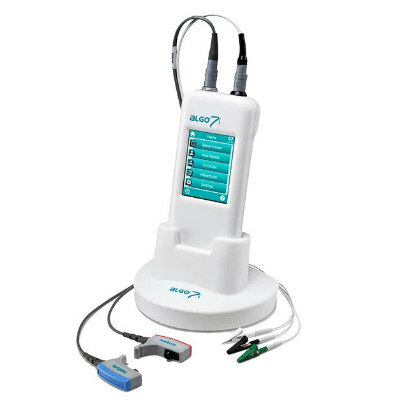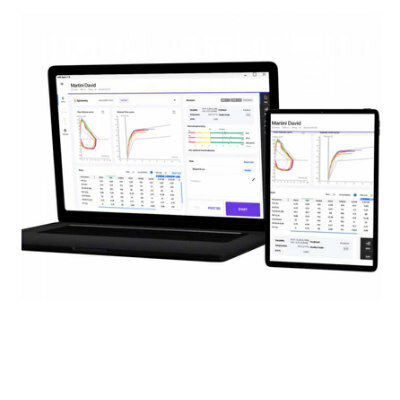Whales Could Hold the Answer for Synthetic Blood 
|
By HospiMedica International staff writers Posted on 07 Oct 2015 |

Image: Myoglobin (red) includes a pocket that is used to store heme (green) (Photo courtesy of Jeff Fitlow/Rice University).
Ultra-stable proteins that allow deep-diving whales to remain active while holding their breath could help create lifesaving synthetic blood, claims a new study.
Researchers at Rice University (Rice, Houston, TX, USA) and the University of Washington (Seattle, USA) conducted a study comparing naturally occurring mammalian myoglobins (Mb) from humans, whales, and other deep-diving mammals. They found that all forms had a common characteristic shape that included a “heme pocket” (much like the pocket of a baseball glove) that traps and releases oxygen. The amount of fully active Mb expressed was directly and strongly dependent on the stability of the heme-free form of Mb, called apomyoglobin (apoMb).
But while the overall shape of Mb in different species is similar, including the shape of their heme pockets, subtle differences in their amino acid sequences causes the more stable myoglobins to better retain their shapes. This underlying stability, however, only becomes apparent when studying the heme-free, apoMb version of the protein. In the study, the researchers confirmed quantitatively that all deep diving mammals have apoMb up to 60 times more stable than human apoMb.
The researchers also systematically analyzed the genes and available information for all mammalian Mbs, including those from 250 deep-diving species, and found that those from aquatic mammals had large positive surface charges compared with those from land animals. They hypothesized that the charge differences allowed aquatic species to pack more Mb into their muscle cells than humans. Finally, the researchers confirmed that the stability of apoMb is directly correlated with expression levels; while very little human Mb is expressed, whales can express 10- to 20-fold higher amounts.
According to the researchers, the results could be used to engineer a strain of bacteria that could generate massive quantities of apoMb that could then be incorporated into synthetic blood for use in transfusions. Since hospitals and trauma specialists currently rely on donated whole blood, which is often in short supply and has a limited storage life, success could mean many more lives saved. The study was published in the September 2015 issue of the Journal of Biological Chemistry.
“Whales and other deep-diving marine mammals can ‘download’ oxygen directly into their skeletal muscles and stay active even when they are holding their breath,” said biochemist Prof. John Olson, PhD, of Rice University. “The reason whale meat is so dark is that it’s filled with myoglobin that is capable of holding oxygen. But when the myoglobin is newly made, it does not yet contain heme. We found that the stability of heme-free myoglobin is the key factor that allows cells to produce high amounts of myoglobin.”
Related Links:
Rice University
University of Washington
Researchers at Rice University (Rice, Houston, TX, USA) and the University of Washington (Seattle, USA) conducted a study comparing naturally occurring mammalian myoglobins (Mb) from humans, whales, and other deep-diving mammals. They found that all forms had a common characteristic shape that included a “heme pocket” (much like the pocket of a baseball glove) that traps and releases oxygen. The amount of fully active Mb expressed was directly and strongly dependent on the stability of the heme-free form of Mb, called apomyoglobin (apoMb).
But while the overall shape of Mb in different species is similar, including the shape of their heme pockets, subtle differences in their amino acid sequences causes the more stable myoglobins to better retain their shapes. This underlying stability, however, only becomes apparent when studying the heme-free, apoMb version of the protein. In the study, the researchers confirmed quantitatively that all deep diving mammals have apoMb up to 60 times more stable than human apoMb.
The researchers also systematically analyzed the genes and available information for all mammalian Mbs, including those from 250 deep-diving species, and found that those from aquatic mammals had large positive surface charges compared with those from land animals. They hypothesized that the charge differences allowed aquatic species to pack more Mb into their muscle cells than humans. Finally, the researchers confirmed that the stability of apoMb is directly correlated with expression levels; while very little human Mb is expressed, whales can express 10- to 20-fold higher amounts.
According to the researchers, the results could be used to engineer a strain of bacteria that could generate massive quantities of apoMb that could then be incorporated into synthetic blood for use in transfusions. Since hospitals and trauma specialists currently rely on donated whole blood, which is often in short supply and has a limited storage life, success could mean many more lives saved. The study was published in the September 2015 issue of the Journal of Biological Chemistry.
“Whales and other deep-diving marine mammals can ‘download’ oxygen directly into their skeletal muscles and stay active even when they are holding their breath,” said biochemist Prof. John Olson, PhD, of Rice University. “The reason whale meat is so dark is that it’s filled with myoglobin that is capable of holding oxygen. But when the myoglobin is newly made, it does not yet contain heme. We found that the stability of heme-free myoglobin is the key factor that allows cells to produce high amounts of myoglobin.”
Related Links:
Rice University
University of Washington
Latest Critical Care News
- Deep-Learning Model Predicts Arrhythmia 30 Minutes before Onset
- Breakthrough Technology Combines Detection and Treatment of Nerve-Related Disorders in Single Procedure
- Plasma Irradiation Promotes Faster Bone Healing
- New Device Treats Acute Kidney Injury from Sepsis
- Study Confirms Safety of DCB-Only Strategy for Treating De Novo Left Main Coronary Artery Disease
- Revascularization Improves Quality of Life for Patients with Chronic Limb Threatening Ischemia
- AI-Driven Prediction Models Accurately Predict Critical Care Patient Deterioration
- Preventive PCI for High-Risk Coronary Plaques Reduces Cardiac Events
- AI Diagnostic Tool Guides Rapid Diagnosis and Prediction of Sepsis
- World's First AI-Powered Sepsis Alert System Detects Sepsis in One Minute
- Smartphone Magnetometer Uses Magnetized Hydrogel to Measure Biomarkers for Disease Diagnosis
- New Technology to Revolutionize Valvular Heart Disease Care
- Super Permeable Wearable Electronics Enable Long-Term Biosignal Monitoring
- New Hydrogel Features Enhanced Capabilities for Treating Aneurysms and Halting Progression
- New AI Tool Predicts Medical Events to Support Clinical Decision-Making in Healthcare Settings
- Bioelectronic Mesh Grows With Cardiac Tissues for Comprehensive Heart Monitoring
Channels
Artificial Intelligence
view channel
AI-Powered Algorithm to Revolutionize Detection of Atrial Fibrillation
Atrial fibrillation (AFib), a condition characterized by an irregular and often rapid heart rate, is linked to increased risks of stroke and heart failure. This is because the irregular heartbeat in AFib... Read more
AI Diagnostic Tool Accurately Detects Valvular Disorders Often Missed by Doctors
Doctors generally use stethoscopes to listen for the characteristic lub-dub sounds made by heart valves opening and closing. They also listen for less prominent sounds that indicate problems with these valves.... Read moreSurgical Techniques
view channel
Hydrogel-Based Miniaturized Electric Generators to Power Biomedical Devices
The development of engineered devices that can harvest and convert the mechanical motion of the human body into electricity is essential for powering bioelectronic devices. This mechanoelectrical energy... Read moreWearable Technology Monitors and Analyzes Surgeons' Posture during Long Surgical Procedures
The physical strain associated with the static postures maintained by neurosurgeons during long operations can lead to fatigue and musculoskeletal problems. An objective assessment of surgical ergonomics... Read more.jpg)
Custom 3D-Printed Orthopedic Implants Transform Joint Replacement Surgery
The evolving field of 3D printing is revolutionizing orthopedics, especially for individuals requiring joint replacement surgeries where traditional implants fail to provide a solution. Although most people... Read more
Cutting-Edge Imaging Platform Detects Residual Breast Cancer Missed During Lumpectomy Surgery
Breast cancer is becoming increasingly common, with statistics indicating that 1 in 8 women will develop the disease in their lifetime. Lumpectomy remains the predominant surgical intervention for treating... Read morePatient Care
view channel
Surgical Capacity Optimization Solution Helps Hospitals Boost OR Utilization
An innovative solution has the capability to transform surgical capacity utilization by targeting the root cause of surgical block time inefficiencies. Fujitsu Limited’s (Tokyo, Japan) Surgical Capacity... Read more
Game-Changing Innovation in Surgical Instrument Sterilization Significantly Improves OR Throughput
A groundbreaking innovation enables hospitals to significantly improve instrument processing time and throughput in operating rooms (ORs) and sterile processing departments. Turbett Surgical, Inc.... Read more
Next Gen ICU Bed to Help Address Complex Critical Care Needs
As the critical care environment becomes increasingly demanding and complex due to evolving hospital needs, there is a pressing requirement for innovations that can facilitate patient recovery.... Read moreGroundbreaking AI-Powered UV-C Disinfection Technology Redefines Infection Control Landscape
Healthcare-associated infection (HCAI) is a widespread complication in healthcare management, posing a significant health risk due to its potential to increase patient morbidity and mortality, prolong... Read moreHealth IT
view channel
Machine Learning Model Improves Mortality Risk Prediction for Cardiac Surgery Patients
Machine learning algorithms have been deployed to create predictive models in various medical fields, with some demonstrating improved outcomes compared to their standard-of-care counterparts.... Read more
Strategic Collaboration to Develop and Integrate Generative AI into Healthcare
Top industry experts have underscored the immediate requirement for healthcare systems and hospitals to respond to severe cost and margin pressures. Close to half of U.S. hospitals ended 2022 in the red... Read more
AI-Enabled Operating Rooms Solution Helps Hospitals Maximize Utilization and Unlock Capacity
For healthcare organizations, optimizing operating room (OR) utilization during prime time hours is a complex challenge. Surgeons and clinics face difficulties in finding available slots for booking cases,... Read more
AI Predicts Pancreatic Cancer Three Years before Diagnosis from Patients’ Medical Records
Screening for common cancers like breast, cervix, and prostate cancer relies on relatively simple and highly effective techniques, such as mammograms, Pap smears, and blood tests. These methods have revolutionized... Read morePoint of Care
view channel
Critical Bleeding Management System to Help Hospitals Further Standardize Viscoelastic Testing
Surgical procedures are often accompanied by significant blood loss and the subsequent high likelihood of the need for allogeneic blood transfusions. These transfusions, while critical, are linked to various... Read more
Point of Care HIV Test Enables Early Infection Diagnosis for Infants
Early diagnosis and initiation of treatment are crucial for the survival of infants infected with HIV (human immunodeficiency virus). Without treatment, approximately 50% of infants who acquire HIV during... Read more
Whole Blood Rapid Test Aids Assessment of Concussion at Patient's Bedside
In the United States annually, approximately five million individuals seek emergency department care for traumatic brain injuries (TBIs), yet over half of those suspecting a concussion may never get it checked.... Read more
New Generation Glucose Hospital Meter System Ensures Accurate, Interference-Free and Safe Use
A new generation glucose hospital meter system now comes with several features that make hospital glucose testing easier and more secure while continuing to offer accuracy, freedom from interference, and... Read moreBusiness
view channel
Johnson & Johnson Acquires Cardiovascular Medical Device Company Shockwave Medical
Johnson & Johnson (New Brunswick, N.J., USA) and Shockwave Medical (Santa Clara, CA, USA) have entered into a definitive agreement under which Johnson & Johnson will acquire all of Shockwave’s... Read more














